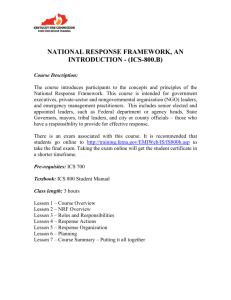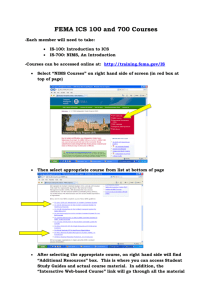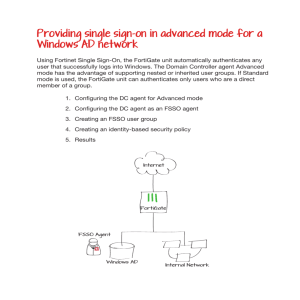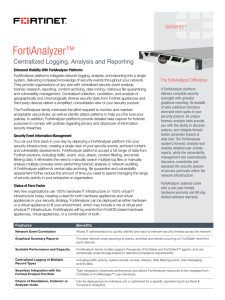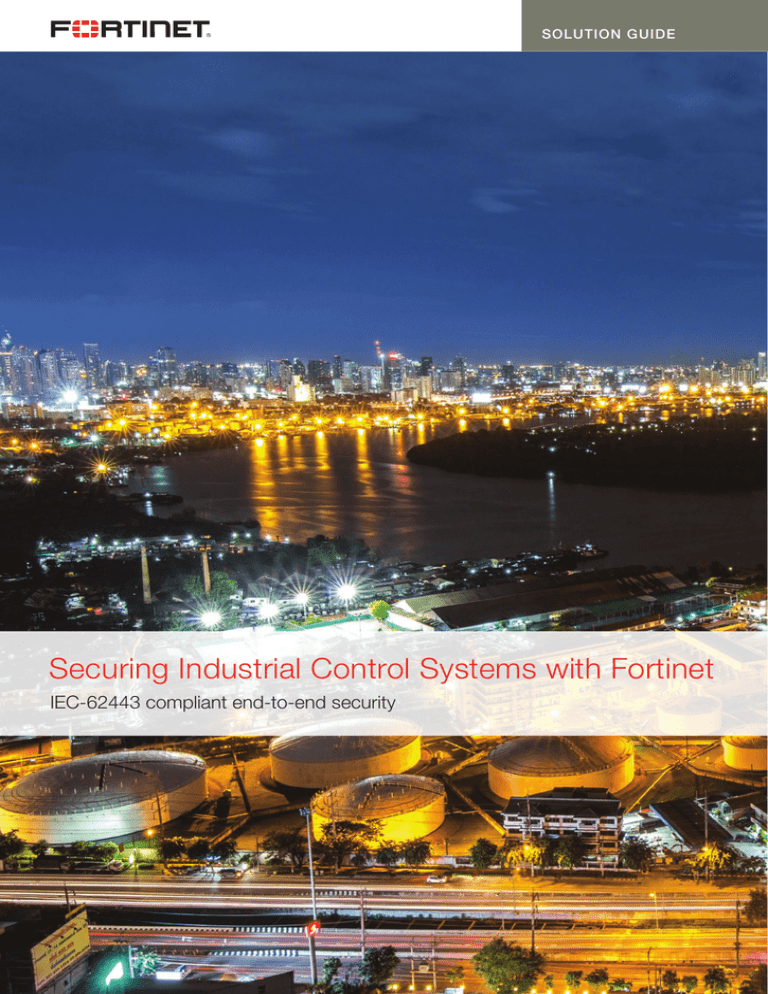
SOLUTION GUIDE
Securing Industrial Control Systems with Fortinet
IEC-62443 compliant end-to-end security
Executive Summary
In recent years, the Industrial Control Systems (ICS) upon which much of our critical infrastructure and manufacturing industry depends,
have come under increasingly frequent and sophisticated cyber-attack.
In part, this is a consequence of the inevitable convergence of Operational Technology (OT) with Information Technology (IT). As in all
spheres of computing, the advantages of increased network connectivity through open standards such as Ethernet and TCP/IP, as well
as the cost savings derived from replacing dedicated proprietary equipment with off-the-shelf hardware and software, come at the cost
of increased vulnerability.
However, while the impact of a security breach on most IT systems is limited to financial loss, attacks on ICS have the added potential
to destroy equipment, threaten national security, and even endanger human life.
With this critical distinction also comes a troubling difference in the profile and motivations of potential attackers. While the lion’s share
of modern cybercrime is motivated by financial reward, ICS have recently become attractive targets for terrorism and cyber-warfare.
As a consequence, the financial and human resources available to its perpetrators can be an order of magnitude greater than those of
conventional cybercriminals. This is especially true of highly targeted state-sponsored attacks, of which STUXNET (first appearing back
in 2010) is considered one of the most sophisticated examples so far.
The purpose of this solutions guide is to show how, in spite of these and many other challenges, Fortinet’s Solutions can help to ensure
the safety and reliability of ICS - and in particular those employing Supervisory Control and Data Acquisition (SCADA) - through the
application of standards-compliant multi-layered network security.
2
www.fortinet.com
SOLUTION GUIDE: SECURING INDUSTRIAL CONTROL
Potential Vulnerabilities
Due to their unique history and conception, separate from the evolving world of IT, ICS present a number of unique challenges:
nnInherent lack of security: Much of the technology underpinning ICS, while extremely robust and reliable, was never designed to be
accessible from remote networks, and so security relied instead upon restricted physical access, and the relative obscurity of its
components (e.g. RTUs, PLCs etc.) and their (mostly serial) communications protocols (e.g. Modbus, RP-570, Profibus, Conitel etc.).
nnThe “air-gap” fallacy: The superficially seductive idea of creating an “air-gap” between the ICS and all other networks is no longer
realistic for the vast majority of real-life applications. As more and more of today’s ICS components rely on software updates and
periodic patching, it is now virtually impossible to avoid at least occasional data transfer into the ICS. Even in the absence of
permanent network connections (or those employing only unidirectional devices such as optical data diodes), ‘air-gapped’ networks
are still vulnerable to the connection of infected PCs or storage devices such as USB drives (one of the infection vectors
of STUXNET).
nnExpanding Attack Surface: As proprietary, dedicated solutions are replaced with off-the-shelf hardware and software, employing open
standards such as Ethernet, TCP/IP, and Wi-Fi, the number of potential vulnerabilities increases exponentially. The recent proliferation
of mobile devices together with trends such as BYOD only exacerbate the problem further.
nnContinued use of outdated hardware and software operating systems (sometimes pre-dating even the very notion of cybersecurity)
which may be incompatible with standard modern defenses such as anti-virus software.
nnInfrequent updates and patching due to the complexity, cost, and potential service disruption entailed. It is not always practical, for
example, to interrupt a plant’s operations whenever one of its operational servers needs patching.
nnLarge numbers of simple, unsecured telemetry devices such as sensors and pressure gauges, whose data, if manipulated, could
nevertheless carry huge consequences for the safety and reliability of the overall system.
nnUse of embedded software written with scant adherence to the security techniques and best practices of modern coding.
nnInsufficient regulation of component manufacture and supply chain, introducing the possibility of equipment compromise, even prior
to installation.
nnLimited Access Control / Permission Management: As previously isolated or closed systems have been interconnected, the controls
imposed on exactly who can access what, have not always kept pace with IT security
best practice.
nnPoor network segmentation: The standard security practice of partitioning networks into functional segments which, while still
interconnected, nevertheless limit the data and applications that can overlap from one segment to another, is still underutilized within
ICS as a whole.
nnLack of security expertise among the engineers who have traditionally designed and maintained the systems.
3
SOLUTION GUIDE: SECURING INDUSTRIAL CONTROL
Addressing the Problem
The good news is that in recent years, the inherent problems and vulnerabilities of ICS have become more widely recognized, and the
first steps have now been taken to rectify them.
One way this is occurring is through the help of government bodies such as the The Industrial Control Systems Cyber Emergency
Response Team (ICS-CERT) in the US, and the Centre for Protection of National Infrastructure (CPNI) in the UK, both of which publish
advice and guidance on security best practice for ICS.
Another way is through the definition of common standards such as ISA/IEC-62443 (formerly ISA-99). Created by the International
Society for Automation (ISA) as ISA-99 and later renumbered 62443 to align with the corresponding International Electro-Technical
Commission (IEC) standards, these documents outline a comprehensive framework for the design, planning, integration and
management of secure ICS.
Although still a work in progress and some way from addressing all vulnerabilities at their most fundamental level, the standard provides
practical guidance, such as the model of ‘zones, conduits, boundaries and security levels’, through which to address the most pressing
deficiencies of ICS network security.
Implementation of the zones and conduits model, which is recommended by both ICS-CERT and CPNI, can greatly reduce the risk of
intrusion, as well as the potential impact should such a breach still occur.
The basic strategy outlined in the standard, is to segment the network into a number of functional ‘zones’ (which may also include
sub-zones), and then to clearly define the ‘conduits’ as all essential data and applications allowed to cross from one zone to another.
Each zone is then assigned a security level from 0 to 5, with 0 representing the highest level of security and 5 the lowest. Strict access
controls can then be imposed limiting access to each zone and conduit based on the authenticated identity of the user or device.
This is a strategy that maps extremely well to the range of capabilities delivered by Fortinet’s Enterprise Solutions, and in particular the
Internal Segmentation Firewall (ISFW).
4
www.fortinet.com
SOLUTION GUIDE: SECURING INDUSTRIAL CONTROL
Securing ISC / SCADA with Fortinet
As with any effective security implementation, the first step is to fully assess the business and operational risks and to define an
appropriate strategy commensurate with those risks. A major part of this will include defining the zones, conduits, boundaries and
security levels outlined in IEC-62443.
This will typically look something like the network represented in figure 1.
remote
user
Level 5
Internet DMZ
Web Servers
Email Servers
Authentication
Servers
Enterprise
Desktops
FortiAuthenticator
FortiManager
FortiAnalyzer
FortiSandbox
remote
vendor
FortiMail
FortiWeb
FortiGate
Firewall
Level 4
Enterprise LAN
Business
Servers
FortiGate
Firewall
Level 3
Operations DMZ
Historian
FortiGate
Rugged Firewall
Domain
Controller
AV Server
Web Servers &
3rd Party Applications
FortiGate
Rugged Firewall
SCADA, DCS, or
EMS System #1
Local HMI
FortiWeb
FortiGate
Rugged Firewall
SCADA, DCS, or
EMS System #2
Local HMI
SCADA, DCS, or
EMS System #3
Local HMI
Level 2
Supervisory
HMI LAN
FortiGate
Rugged Firewall
Level 1
Controller LAN
Level 0
Instrumentation
bus network
Figure 1: Security levels as depicted in the ISA S99 standard
5
SOLUTION GUIDE: SECURING INDUSTRIAL CONTROL
Comprehensive multi-layered Security
With its multi-layered defense in depth, high availability design, and optional rugged form-factor, the FortiGate range of security
appliances is the perfect choice for implementing the zones and conduits model, no matter how critical the ICS infrastructure, or how
harsh the environment.
Using the deployment mode of “Internal Segmentation Firewall” (ISFW), which combines Functional and physical segmentation, the
FortiGate combines advanced high-performance firewall functionality and robust two-factor authentication, with anti-virus, intrusion
prevention, URL filtering, and Application Control. With a wide selection of high speed LAN interfaces and the hardware acceleration
derived from its custom ASIC design, the FortiGate has been proven to deliver inter-zone performance in excess of 100Gbps.
Using the granular security policies available with FortiGate’s ISFW deployment mode, ICS zones and conduits can be enforced based
on criteria such as user identity, application, location, and device type. In this way, the FortiGate™ can effectively lock down each zone,
ensuring that only legitimate, prescribed traffic, originating from authorized endpoints can pass from one zone to another.
For an alternative implementation of sub-zones, the FortiGate and FortiSwitch™ appliances also support 802.1Q VLAN traffic tagging,
although in most critical deployments, the ISFW mode provides greater isolation and containment and is therefore recommended over
the use of VLANs.
The embedded security of these highly flexible and scalable products comes from a combination of their operating system, FortiOS™,
the FortiAuthenticator™ and FortiToken™ authentication solutions, and the automated, 24/7, self-learning, continuous threat response
resources of FortiGuard™.
Centralized Management, logging and reporting
Management of the infrastructure, which is all consolidated through the FortiGate, is accomplished via FortiManager™ and
FortiAnalyzer™, combining centralized configuration with reporting, visibility, event logging and analysis, to create a comprehensive,
real-time network monitoring and control center
Specific ICS- / SCADA-aware functionality
Using predefined and continually updated signatures, the FortiGate can identify and police most of the common ICS / SCADA
protocols (see list below) for the purpose of defining conduits.
• Bacnet
• DNP3
• ICCP
• Modbus/TCP
• DLMS/COSEM
• EtherCAT
• IEC-60870.5.104
• OPC
• Profinet
This is done through the configuration of security policies in which multiple services, such as IPS, AV, and Application Control can be
mapped to each protocol.
In parallel to this specific protocol support, additional vulnerability protection is provided for applications and devices from the major
ICS manufacturers (see list below) through a complementary set of signatures.
• ABB
• Elcom
• Rockwell
• Seimens
• Advantech
• GE
• Schneider Electric
• Vedeer Root
• Yokogawa
This provides a more granular application-level control of the traffic between zones and enables the FortiGate to detect attempted
exploits of known vulnerabilities relating to any of the supported vendors’ solutions.
6
www.fortinet.com
SOLUTION GUIDE: SECURING INDUSTRIAL CONTROL
Zone Access Control with
FortiAuthenticator and
FortiToken
Securing the #1 Attack vector
with FortiMail
Although not specific to ICS or its components, unsecured Email
Applying granular control of the access to each zone and conduit
– especially when combined with social engineering – remains
based on both user and device is the role of FortiAuthenticator’s
the #1 attack vector for the majority of known threats.
integration with FortiGate and directory services.
Protecting against inbound attacks, including advanced malware,
FortiAuthenticator User Identity Management Appliances provide
as well as outbound threats and data loss, FortiMail™ provides a
Two-factor Authentication, RADIUS, LDAP and 802.1X Wireless
single solution combining anti-spam, anti-phishing, anti-malware,
Authentication, Certificate management and Fortinet Single Sign-
sandboxing, data leakage prevention (DLP), identity based
on. FortiAuthenticator is compatible with and complements the
encryption (IBE), and message archiving.
FortiToken range of Two-Factor Authentication Tokens for Secure
Remote Access enabling authentication with multiple FortiGate
network security appliances and third party devices. Together,
FortiAuthenticator and FortiToken deliver scalable, cost-effective,
secure authentication to your entire network infrastructure.
Securing the Historian
with FortiDB
Responding to Advanced Persistent Threats
Most of the discussion so far has focused on the detection
and blocking of attacks through the use of signatures, yet this
approach relies on having encountered some close variant of
the threat before. With the extensive threat response resources
of FortiGuard continually monitoring thousands of live customer
networks around the world, this is extremely likely, but with the
All central databases present an attractive target for cyber-
stakes for ICS intrusion so high, it is essential to also prepare for
attack, but those underpinning ICS may be especially vulnerable
attacks which have yet to be encountered.
since, due to their history, security may not have been a major
consideration in their deployment and scripting.
In such a scenario, it becomes crucial that the intrusion
is detected rapidly, its propagation limited, and its impact
To help assess the current security level, address any
minimized. Here, a critical component of Fortinet’s Advanced
vulnerabilities, and monitor all subsequent access for suspicious
Persistent Threat Protection Framework is FortiSandbox™, which
activity, FortiDB provides a flexible policy framework through
is designed to detect and analyze advanced attacks that might
which to secure these critical resources.
bypass more traditional signature-based defenses.
Securing the Web-based HMI
with FortiWeb
Government Accreditation and Assurance
Compliant with US Federal Government standard FIPS 140-2
While the cost and usability benefits of controlling the ICS
level 2 for Cryptographic Modules, and International Common
through a web-based console are self-evident, the impact of
Criteria certification EAL 4+, Fortinet delivers robust, field-proven,
intrusion or compromise to the back-end is clearly much greater
protection that has been evaluated and tested by numerous
within this environment than for most other web-servers.
third-party organizations to the highest levels of any multi-layered
security solution.
Using advanced techniques to provide bidirectional protection
against malicious sources, application layer DoS Attacks, and
sophisticated threats like SQL injection and cross-site scripting,
FortiWeb adds another crucial layer to your ICS defenses.
7
Summary
Adequately securing ICS presents many significant challenges, some of which clearly go beyond the scope of this solutions guide.
Yet by following the best practices set forth by ICS-CERT / CPNI, and deploying government accredited solutions such as those of
the Fortinet portfolio outlined above, the probability of a successful cyber-attack, as well as its likely impact on the ICS, can be greatly
reduced.
With dedicated support for the ICS / SCADA environment as well as its proven success as a leading provider of multi-layered enterprise
security, Fortinet is uniquely positioned to help our industrial customers overcome their security challenges and protect the safety and
reliability of our most critical infrastructure and services.
GLOBAL HEADQUARTERS
Fortinet Inc.
899 Kifer Road
Sunnyvale, CA 94086
United States
Tel: +1.408.235.7700
www.fortinet.com/sales
EMEA SALES OFFICE
120 rue Albert Caquot
06560, Sophia Antipolis,
France
Tel: +33.4.8987.0510
APAC SALES OFFICE
300 Beach Road 20-01
The Concourse
Singapore 199555
Tel: +65.6513.3730
LATIN AMERICA SALES OFFICE
Prol. Paseo de la Reforma 115 Int. 702
Col. Lomas de Santa Fe,
C.P. 01219
Del. Alvaro Obregón
México D.F.
Tel: 011-52-(55) 5524-8480
Copyright © 2015 Fortinet, Inc. All rights reserved. Fortinet®, FortiGate®, FortiCare® and FortiGuard®, and certain other marks are registered trademarks of Fortinet, Inc., and other Fortinet names herein may also be registered and/or common law trademarks of Fortinet. All other product or
company names may be trademarks of their respective owners. Performance and other metrics contained herein were attained in internal lab tests under ideal conditions, and actual performance and other resultsmay vary. Network variables, different network environments and other conditions
may affect performance results. Nothing herein represents any binding commitment by Fortinet, and Fortinet disclaims all warranties, whether express or implied, except to the extent Fortinet enters a binding written contract, signed by Fortinet’s General Counsel, with a purchaser that expressly
warrants that the identified product will perform according to certain expressly-identified performance metrics and, in such event, only the specific performance metrics expressly identified in such binding written contract shall be binding on Fortinet. For absolute clarity, any such warranty will be
limited to performance in the same ideal conditions as in Fortinet’s internal lab tests. Fortinet disclaims in full any covenants, representations,and guarantees pursuant hereto, whether express or implied. Fortinet reserves the right to change, modify, transfer, or otherwise revise this publication
without notice, and the most current version of the publication shall be applicable. 05 Oct 2015 – 5:07 PM MKT-STORAGE:01_BROCHURES:05_SOLUTION_GUIDES:SG-Securing Industrial Control:Securing Industrial Control Folder:Securing Industrial Control
www.fortinet.com

